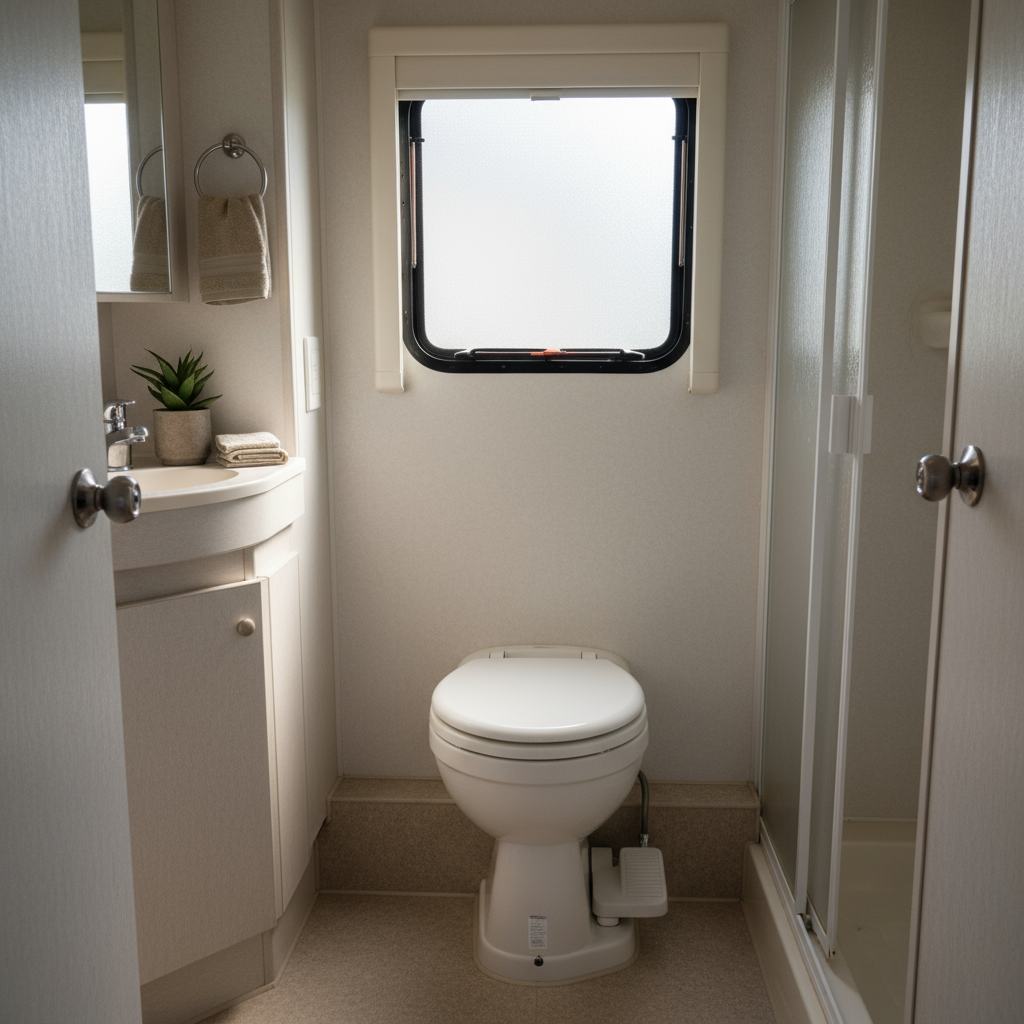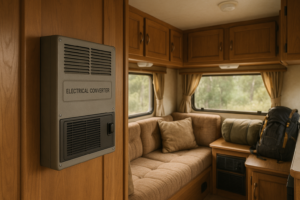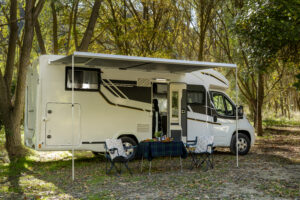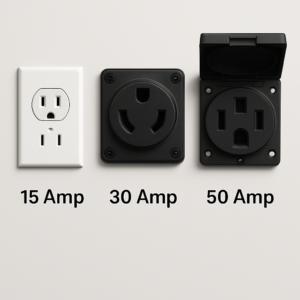
Why Does My RV Toilet Smell When Flushed?
Table of Contents
As a camper, only a few things can disrupt your mood more than camper toilet stinks. While you are enjoying the scenic views and open roads in your RV, dealing with RV toilet smells when flushed can be a big turn-off. Ranging from mildly irritating to downright overpowering, these smells can leave you wondering what’s causing them and how to get rid of them.
Dealing with toilet odors in your RV is important for both comfort and hygiene. Left unchecked, these smells can make the space unpleasant and may even lead to bigger issues in the plumbing or waste system.
This guide covers the most common reasons behind toilet odors and offers practical solutions. From tackling major problems, such as faulty parts, to simple fixes like regular cleaning, you’ll learn how to identify the cause and keep your RV fresh.
Understanding the RV Toilet System
Before tackling odors, it’s important to know how your RV toilet works. Each part of the system plays a role in handling waste and controlling smells, and understanding them makes it easier to find and fix problems. To learn more, check out our guide on everything you need to know about RV toilets.
RV Toilet System and How It Controls Odors
An RV toilet looks similar to a household one, but it’s part of a connected system designed to manage waste and control smells. Here’s how the key components work together:
- Toilet: Flushes waste directly into the system.
- Black Tank: Stores waste securely until emptied.
- Vent Pipe: Allows airflow to release gases and prevent buildup.
- Seals: Create a tight barrier, keeping odors contained.
When functioning properly, these parts work in harmony to keep your RV fresh. The toilet directs waste into the black tank, while the vent pipe channels gases outside. Seals prevent leaks and odors from escaping, and tank treatments or chemicals can help neutralize smells. If any component fails, odors can quickly spread, so regular checks and maintenance are essential.
Common Causes of Odor When Flushing
Several factors can contribute to RV toilet smells when flushed. Identifying the root cause is the very first step to any RV toilet smell remedy. Let’s find out the common culprits behind unpleasant smells in your RV and how they affect your toilet system.
Clogged or Blocked Vent Pipe
A vent pipe allows air to pass through the black tank and release built-up gases. When it gets clogged or blocked, it disrupts the balance and ultimately, your RV experience.
- Role of the Vent Pipe in Odor Control: The vent pipe releases built-up pressure and ensures the gases can escape from the black tank.
- Signs of Blockage: Strange bubbling sounds when flushed and odors escaping during operation
Solutions: Check and clean the pipe with a vent cleaning tool. Look for leaves, debris, or other objects blocking the pipe.
Damaged or Worn Toilet Seal
A toilet seal works as a barrier between the black tank and the inside of your RV. A damaged or worn-down seal can leak unpleasant odors into your RV’s interior.
- Role of the Toilet Seal in Preventing Odors: The toilet seal ensures a tight closure between the toilet and the waste system. The gate valve seal in the toilet bowl also plays a crucial role by holding water in the bowl, which acts as a barrier to stop odors from escaping the black tank.
- Signs of Seal Failure: Signs of a damaged seal include water pooling around the base of the toilet, persistent smells even when the toilet is not in use, or gaps around the toilet’s edge.
Solutions: Inspect and clean the seal regularly. If the seal is damaged or worn out, replace it with a new one to restore the system.
Improperly Sealed Toilet Flange
The toilet flange secures the toilet to the RV’s waste system. A properly sealed flange prevents leaks and odors and ensures the waste is properly directed into the tank.
- Role of a Secure Flange Connection: The flange creates a seal between the toilet and the waste pipe and keeps odors contained. A loose or improperly sealed flange compromises this barrier.
- Signs of Leaks at the Base of the Toilet: Leaks around the toilet base can lead to water pooling, persistent smells, and potential damage to the RV floor due to prolonged exposure to moisture.
Solutions: Tighten the bolts securing the toilet to the flange and check the gasket for wear. If necessary, replace the gasket and ensure the flange is properly aligned and sealed to prevent leaks.
Inadequate Tank Treatments
Proper tank treatments break down waste and neutralize odors in the black tank. To work effectively, the chemicals need to be added with a generous amount of water so they can mix properly and dissolve the waste. Without the right chemicals and enzymes, waste can build up and cause persistent smells.
- Role of Enzymes and Chemicals: Tank treatments with enzymes and chemicals help break down waste, prevent clogs, and control odors by maintaining a healthy microbial balance in the tank. They also lubricate the seals and the inside of the tank, allowing waste to drain more freely and helping the termination valve function smoothly.
- Signs of Ineffective Treatment: If you notice lingering smells despite using tank treatments, this could be a sign that the chemicals or enzymes are not effective or properly balanced.
Solutions: Use the proper tank treatments for your RV recommended by the manufacturer. Regularly check and follow the manufacturer’s guidelines to ensure the treatments are working as intended. You can also learn more about cleaning and maintaining your black tank to keep it in good condition.
Exhaust Fan Usage During Flushing
While exhaust fans are great for ventilation, they can create negative pressure during toilet flushing and draw odors back into the RV.
Recommendations: Always turn off exhaust fans before flushing. This easy and simple action will maintain the positive flow and allow odors to vent properly.
Step-by-Step Troubleshooting Guide
When facing toilet odor problems, the right approach makes them manageable. The following is the step-by-step process to troubleshoot common RV toilet smells when flushed:
1. Inspect the Vent Pipe
- Check for Obstructions or Debris: A blocked vent pipe can trap gases and cause odors to back up into your RV. Look for any visible blockages such as leaves, bird nests, or dirt.
- Use a Hose to Flush Out Any Blockages: If you find debris, flush the vent pipe with water to clear the obstruction and allow proper airflow to prevent future RV toilet smell problems.
2. Examine the Toilet Seal
- Look for Visible Damage or Wear: Check the toilet seal for cracks or wear. A compromised seal can lead to leaks and odors.
- Replace the Seal if Compromised: If you notice any damage, replace the seal to prevent camper toilet stinks and maintain a fresh RV environment.
3. Evaluate Tank Treatment
- Ensure Correct Product Use and Dosage: Double-check that you’re using the correct tank treatment and following the manufacturer’s recommended dosage.
- Switch to a Different Treatment if the Current One is Ineffective: If you’re still experiencing smells, try a different treatment product to ensure waste is breaking down effectively and odors are neutralized.
4. Manage Exhaust Fan Usage
- Avoid Using the Fan During Flushing: Using the exhaust fan while flushing can create negative pressure, pulling odors into the RV. Turn the fan off before flushing to prevent this.
- Use the Fan Only After Flushing is Complete: Once the toilet is flushed and sealed, turn the exhaust fan on to ensure fresh air circulates and odors are properly vented.
5. Check the Toilet Flange
- Tighten or Replace the Flange as Needed: A loose or improperly sealed toilet flange can cause leaks and odors. Tighten the bolts just enough to secure the toilet, avoiding overtightening. If the flange is damaged, replace it to prevent further issues.
- Ensure a Secure Connection to Prevent Leaks: Make sure the flange is securely connected to the RV plumbing to avoid any potential leaks or odors seeping out.
Additional Tips for Odor Prevention
Preventing RV toilet odors requires more than just addressing the immediate issues — consistent maintenance and mindful practices play a key role in keeping your RV smelling fresh.
- Regular Cleaning: Clean the toilet bowl and surrounding area on a regular basis to remove any buildup that could cause unpleasant smells or bacteria growth.
- Ensure Bowl Holds Water: Make sure the toilet bowl is holding water. If water seeps out, the gate valve seal may need to be cleaned or replaced. Be careful not to drop anything into the tank while cleaning.
- Proper Ventilation: Ensure there’s adequate airflow in the bathroom to prevent stagnant air and reduce the buildup of odors. Open a window or use the vent fan to circulate air.
- Use RV-Safe Products: Choose cleaning products, deodorizers, and tank treatments specifically designed for RVs. These are formulated to protect your plumbing and prevent damage while keeping odors at bay.
- Routine Maintenance: Perform regular checks on the toilet system, including inspecting seals, the vent pipe, and the tank. This ensures that everything is functioning correctly and helps you catch any issues before they lead to odors.
When to Seek Professional Help
While many RV toilet odor problems can be solved with basic troubleshooting, there are situations where professional help is needed to resolve more complex issues. If the problem persists despite your best efforts and ruins your RV adventure, it may be time to consult the experts at Good Sam RV ProCare.
Persistent Odors
If odors exist even after cleaning, inspecting seals, and checking the vent system, it could be a sign of deeper issues within the system that require professional assessment.
Complex Issues
For problems that go beyond basic maintenance, such as faulty motors, extensive plumbing issues, or electrical failures, it’s best to consult a professional who can handle the complexity of the repair.
System Failures
If you notice any damaged or malfunctioning components, such as a broken motor, a leaking black tank, or damaged plumbing, you may need to get in touch with professional RV toilet installation services.
Conclusion
Maintaining a fresh-smelling camper toilet is essential for a comfortable and hygienic RV experience. Fixing RV toilet odor problems quickly not only ensures a pleasant environment but also helps prolong the lifespan of your toilet system.
Should you encounter more complex problems or need professional assistance, Good Sam RV ProCare is here to help with expert inspections and repairs. Explore our services to ensure your RV stays fresh, functional, and ready for your next adventure.
Frequently Asked Questions (FAQs)
Why does my RV toilet smell like sewage when flushed?
The most common cause of a sewage smell is a blockage in the vent pipe, a damaged toilet seal, or a full black tank. Ensure proper venting, check seals, and maintain regular waste disposal.
What should I do if my RV's black tank vent pipe is blocked?
Inspect the vent pipe for any obstructions such as debris or bird nests. Use a hose to flush out any blockages. If it persists, consider using a vent cleaning tool or consulting a professional.
How often should I clean my RV toilet to prevent odors?
Clean your RV toilet regularly, at least once a week or after every trip. This includes wiping down the bowl, cleaning the surrounding area, and ensuring the black tank is treated with the appropriate chemicals.
How to deep clean an RV toilet?
Deep clean by removing waste buildup from the toilet bowl, flushing out the black tank with water, and applying a specialized tank cleaner. Clean and lubricate the rails and seals to ensure smooth operation.


